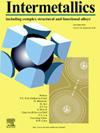Enhanced plastic deformation in amorphous alloys via synergistic effects of hydrogen doping and rejuvenation
IF 4.3
2区 材料科学
Q2 CHEMISTRY, PHYSICAL
引用次数: 0
Abstract
Amorphous alloys have gained substantial attention due to their exceptional physical and chemical properties. However, their brittleness at room temperature has limited their widespread application. This study investigated the synergistic effects of hydrogen doping and rejuvenation on the plastic deformation capability of amorphous alloys using molecular dynamics simulations. It was revealed that low contents of hydrogen doping can significantly enhance the plastic deformation capability of amorphous alloys. However, an excessive amount of hydrogen doping could lead to a reduction in both the strength and plasticity of amorphous alloys. Cyclic shear treatment promotes the rejuvenation of amorphous alloys by increasing free volume. The synergistic of hydrogen doping and rejuvenation could further improve the plasticity of amorphous alloys. Voronoi analysis reveals that the synergistic of hydrogen doping and rejuvenation induces the rearrangement of microstructure of amorphous alloys, reduces the content of ordered clusters and increases the proportion of disordered structures. Thereby the occupancy of hydrogen atoms and the overall energy state of amorphous alloys were affected. By controlling the content of hydrogen doping and the synergistic with cyclic shear rejuvenation, the mechanical properties of amorphous alloys can be effectively regulated, offering new insights for the application of amorphous alloys.
通过氢掺杂和回春的协同效应增强非晶合金的塑性变形
非晶合金因其特殊的物理和化学性质而受到广泛关注。然而,它们在室温下的脆性限制了它们的广泛应用。采用分子动力学模拟方法研究了氢掺杂和回弹对非晶合金塑性变形能力的协同效应。结果表明,低含量的氢掺杂能显著提高非晶合金的塑性变形能力。然而,过量的氢掺杂会导致非晶合金的强度和塑性降低。循环剪切处理通过增加自由体积促进非晶合金的回春。氢掺杂与回春的协同作用可进一步提高非晶合金的塑性。Voronoi分析表明,氢掺杂与回火的协同作用导致非晶合金组织的重排,有序团簇的含量减少,无序结构的比例增加。从而影响了非晶合金的氢原子占位和总能态。通过控制氢掺杂的含量和循环剪切再生的协同作用,可以有效调控非晶合金的力学性能,为非晶合金的应用提供新的思路。
本文章由计算机程序翻译,如有差异,请以英文原文为准。
求助全文
约1分钟内获得全文
求助全文
来源期刊

Intermetallics
工程技术-材料科学:综合
CiteScore
7.80
自引率
9.10%
发文量
291
审稿时长
37 days
期刊介绍:
This journal is a platform for publishing innovative research and overviews for advancing our understanding of the structure, property, and functionality of complex metallic alloys, including intermetallics, metallic glasses, and high entropy alloys.
The journal reports the science and engineering of metallic materials in the following aspects:
Theories and experiments which address the relationship between property and structure in all length scales.
Physical modeling and numerical simulations which provide a comprehensive understanding of experimental observations.
Stimulated methodologies to characterize the structure and chemistry of materials that correlate the properties.
Technological applications resulting from the understanding of property-structure relationship in materials.
Novel and cutting-edge results warranting rapid communication.
The journal also publishes special issues on selected topics and overviews by invitation only.
 求助内容:
求助内容: 应助结果提醒方式:
应助结果提醒方式:


